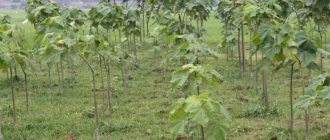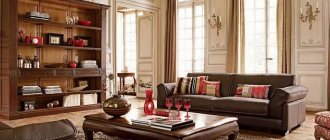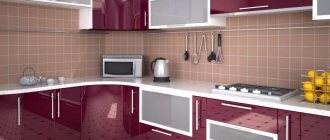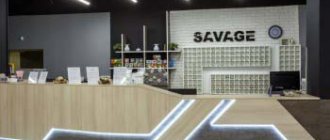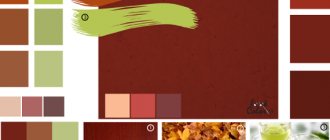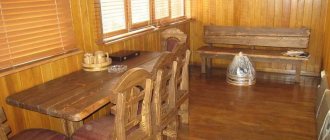Kitchen with white cabinets and wooden island
Let's count all the beautiful trees together! Discover 10 amazing types of wood that, when used in the interior design of an apartment or house, can transform and reveal the enormous style potential of any room.
Unique patterns, special texture, incredible color shades. What would you and I, dear visitors of the Design Museum, do without wood?
All wood, despite hundreds of hundreds of its varieties, is divided into two huge categories: created by nature and created by man.
The first is all the wood surfaces in your home, be it pine with its strong roots or foreign Brazilian cherry, a natural element of a floor, a cabinet or even something as simple as a picture frame.
Trees require sun, soil and water, but the result is pleasing to us, because regardless of the chosen style, we always have perfectly processed raw materials for construction and decoration.
Another category of wood has fewer varieties, but they are all surprisingly similar to each other. These “forests” are known as Hollywood, Bollywood, Lollywood and even Nollywood. (Wood is a component of these names of the American, Indian, Pakistani and Nigerian film industries - “tree” in English.)
These “wooden” dream factories raised not only film and show business to the highest level. They offered a new standard of luxurious living, splendor and dizzying beauty. Let's take a look at the Hollywood-approved examples.
So, before the experienced reader are 10 natural finishing and decorative materials that will turn an ordinary and predictable room into a work of art that pleases the eye.
Oak
Rustic kitchen with unpainted oak planks
This is a strong and noble tree that stuns our imagination. Perhaps you have childhood memories of building a house in its branches.
Or there is such a giant standing in your yard, protecting everyone from the sun with its mighty crown. The nobility of oak is visible even when, devoid of life, it has turned into things - dining tables and chairs.
The best countertops for the kitchen - oak - with royal grandeur endure hot pots, the humidity of ice-filled glasses and our elbows propping up our tired heads, filled with the impressions of the past day.
As you pour the wine into your glass, remember that perhaps a barrel made from one of the 600 varieties of oak helped the wine mature. Don't forget about the cork that is made from its bark. As you can see, the role of an artillery shell in children's games is not the only purpose of the acorn.
Imitation of wood texture with plaster
One of the inexpensive and proven ways to obtain an effective wood-look finish is decorative plaster. Types that imitate the texture of trees such as oak, ash, cherry, and walnut are sold. Plaster has significant advantages over other materials:
- suitable for most surfaces;
- you can cover both small pieces and the entire area;
- withstands adverse conditions, temperature changes and is therefore suitable for outdoor use;
- non-flammable;
- You can easily and quickly restore the damaged area.
The main disadvantage is that the imitation only looks good from a long distance. In addition, unlike real wood, the strength and wear resistance are several times less.
Which plaster is suitable
The choice of material depends on the further conditions of use of the surface. For example, the façade of a building is made of putty. Cement plaster works well on concrete. Indoors, you can give preference to materials based on gypsum, acrylic or silicone. The bark or wormholes made by beetles are well conveyed by relief structural plaster with coarse granules. Ready-made mixtures of acrylic and silicone are practical to use. They do not harden instantly and allow you to adjust the process.
Required Tools
The range of devices is determined after choosing the breed that needs to be created. You may need:
- squeegee spatulas with different notches;
- various spatulas (metal, rubber, flexible and others);
- rollers with relief patterns;
- brushes with hard bristles;
- trowel.
It is advisable to purchase expensive equipment only for large volumes of work or when they are carried out to order. In most cases, you can get by with improvised means. So, it’s easy to add texture to a regular paint roller by wrapping it with tape, thread or film.
The procedure for creating wood texture
At first glance, the work may seem quite painstaking, but understanding the technology will not be difficult. Before you start working, you should practice on a piece of cardboard. Follow the following sequence of actions:
- Treat a small area with putty and level it to a thickness of 6 mm. Carefully smooth the surface with a spatula.
- Next, apply wavy grooves in a vertical, horizontal direction or at an angle. After each pass, the instrument is cleaned.
- Then we form a glossy base on the wall with a hard spatula.
- The plaster should dry for 30 minutes.
- Using a brush, distribute the primer over the surface. It is important that it gets into all the cracks.
- Then the surface is coated with paint, dried and, if necessary, smoothed.
Cedar
Minimalist cedar kitchen stools
We know this tree mainly by its ability to repel moths and other insects with its pungent odor. Cedar, which has spread to different parts of the planet, has many varieties.
Therefore, the scope of application of this sweet fragrant wood with a red and red-brown tint is very extensive: fencing, roofing material, room partitions, guitars and even shipbuilding. Well, beware of high waves and nasty bugs - the cedar can handle you!
Wood imitation paints
Many designers and artists practice the use of paints and varnishes. The most popular method is to sequentially overlay contrasting shades on top of each other and then process them with special brushes . This method is more realistic.
Tools for work
To work you will need:
- tools for applying the first layer - brush, sponge or paint roller.
- brush with artificial bristles for glazing;
- rocker to create a pattern;
- soft brush made of natural fibers;
- pencil, ruler, tape;
- piece of fabric;
- thickener for acrylic;
- finishing coating.
Shades for the first layer
For the base, regular white acrylic paint is suitable. In stores you can find special tinting compounds and by mixing to achieve the desired shade. The easiest way is to use gouache paints. It is better to conduct color experiments on sheets of plywood or MDF. It is important that the initial layer is a couple of shades lighter than the glaze. Manufacturers offer a wide range of shades for the base layer:
- iron oxide is red;
- burnt umber or sienna;
- natural sienna;
- milky beige.
Shades as glaze
The final color will depend on the compatibility of the first layer with the color of the glaze. The composition should include two parts acrylic or latex paint and one part thickener. The following shades can be used as glaze:
- burnt umber and sienna;
- black;
- red iron oxide.
Work order
Many people note that the method of simulating texture using paint is the most familiar and understandable. To properly make the coating, follow these steps:
- First you need to apply a light color using a brush or sponge.
- Wait for the paint to dry.
- Next, mix the glaze to apply a decorative coating.
- An even layer of glaze is applied on top of the first layer. It is better to work with a small area of the area.
- Then slowly run a rocker over the wet icing, creating rows.
- To achieve the best effect, periodically remove dirt from the instrument.
- Occasionally, you can move along the surface not with the tool itself, but with a comb or grooves.
- Before drying, the layer is treated with a soft brush along the direction of the wood fibers.
- Wait until the surface is completely dry and use it for its intended purpose.
It is advisable to try the technique on a cardboard sheet of medium configuration. Only after achieving the desired effect can you begin to work on the real surface. It’s also worth trying the topcoat so that unexpected nuances do not arise in the future.
Thus, there are proven ways to create realistic wood imitations. Using the recommendations proposed in this article, you can make a unique wood-look material with your own hands and without the help of specialists. The main thing is to prepare the necessary tools in advance and choose a more understandable method.
Padauk
Padauk kitchen countertop
The original name of this tree, which grows in Asia and Africa, is pterocarpus; its very hard flesh lends itself well to processing.
It is used to make carved figurines, musical instruments, and complex original furniture, since padauk is stronger than oak, and its reliable red wood can withstand gluing.
Teak
Teak cabinets in sleek modern kitchen
This is a great opportunity to bring the color and majesty of the tropics into your home design. Teak, the national tree of the Philippines, is a very hard wood species. It is characterized by greenish, yellow and brown shades.
The application is very diverse: doors, window frames, home and garden furniture. Often, during the process of aging and maturing, the treated teak surface acquires a silver-gray tone. Doesn't remind you of anything?
Walnut
Modern white kitchen with walnut cabinets
Oh, how delicious your fruits are, dear walnut! But your role is no less honorable when you are the finishing material for the floor under our feet or for the rocking chair in which a mother rocks her baby. And, of course, you are so harmonious in the decoration of the piano.
Ultra-modern walnut flooring
Walnut grows in many countries with different climatic conditions, so its color palette is very rich.
But most of all, it is valued for its reliability, since it has a low degree of shrinkage and is not subject to compression or expansion, like other wood species, which allows its use in aircraft construction. Whether high in the air or below your feet, walnut is a great ally for designers.
Why imitate wood?
Imitation allows you to create a variety of wood textures, cuts in longitudinal and transverse sections, the structure of old petrified rock or eaten away by insects, as well as make spectacular stylistic variations. After all, the use of natural wood varieties is in many cases impractical and unjustified.
Patterning tools
You can apply the selected material to the wall using a spatula or trowel. To develop a drawing, the following tools are required:
- palette knife;
- textured roller;
- video with the image of a wood cut;
- rubber spatula with a pattern;
- various models of spatulas;
- stencil.
How to make a wood-look spatula with your own hands
There is no need to buy an expensive spatula. It can be cut from ordinary plastic packaging from construction or other materials. First they draw a shape, and then cut it out with well-sharpened scissors and form notches. The following types of spatulas will be needed:
- wide with large teeth;
- medium with sparse serrations;
- small smooth.
Alder
Alder double bed
The wood is quite soft, but its elasticity is not a drawback in the eyes of cabinetmakers. This is the most common material for the production of furniture and interior decoration. Alder can be easily polished and painted, acquiring the desired shade and texture. Regardless of fashion trends, these products are always in demand on the market.
Amaranth
Amaranth coffee table
Native to the tropical forests of South America, it is highly prized throughout the world for its shiny, fibrous, patterned texture.
Flexible, yet durable, resistant to fungus and wood pests, amaranth is an excellent material for the furniture industry.
But the most important trump card of this material is its deep natural purple color, for which the tree received its second name - “purple heart”.
Amaranth, which changes color under the influence of air and sunlight immediately after cutting, is a real forest miracle.
Eucalyptus
Eucalyptus floor combined with mahogany walls
Exotic things excite and attract us. For example, a koala. Agree, this rare and beautiful animal demonstrates great demands on raw materials for carpentry.
Eucalyptus - which is what koalas prefer as a daily diet - provides humanity with wood of a natural yellowish-pink hue, which becomes darker when exposed to ultraviolet rays.
This wood is great for making floorboards, as well as furniture, doors, frames and moldings. Many corners of your home are ready to “taste”, like a koala, the taste of eucalyptus.
The color of the tree, depending on its species:
Birch is a yellowish shade with a weak texture and good susceptibility to processing and sanding. Birch furniture is mostly light in color and is used for home furnishings or offices.
Pine is perhaps the most common type of natural material. The tree retains its scent for a long time and has an exceptional golden hue. It is used mainly in private construction, for cottages and country houses.
Walnut is a bit of a capricious material. However, the years will only benefit him. The color palette is extensive, from yellowish to black. Walnut furniture fits well into the interior of salons, restaurants, and apartments.
Oak is famous for its solidity and longevity, surviving centuries and eras well. Exquisite English libraries of the 18th century have survived to this day, with oak bookshelves that have not lost their attractiveness. So if you want your furniture to be inherited by your descendants, order it from oak.
Beech is a light wood. Allows you to create furniture with curved backs and ornate legs. Beech lends itself well to processing and retains its color for a long time.
Mahogany - the beauty of mahogany furniture is not only in its natural shade, which when polished acquires a reddish shimmer, but also in its special sensitivity to sound transmission. This type of wood is suitable for creating expensive violins, guitars and other musical instruments. Furniture made from it is usually massive, formal, created for large sets for many people.
Ebony is very dark (almost black), with a texture of light stripes. Expensive and durable. Products made from it can last for centuries.
You can order any decor items, furniture, gifts and souvenirs made from natural wood from our company. We carry out cutting, milling, engraving and other milling work on wood on CNC machines. Favorable prices and decent quality are guaranteed. Call!
Maple
Cozy bedroom with maple TV stand and chest of drawers
Its wood serves as a base for making simple things like baseball bats or bowling balls, but its sharp, distinct grain makes it suitable for decorative home decor as well.
Flooring, wall paneling, furniture... It is quite beautiful to serve as just a backdrop and is often transformed into exquisite woodwork.
Wood textures:
Alternating stripes:
This pattern is typical for rosewood, walnut and mahogany. Formed when a block of wood is cut in a radial plane. Rosewood and walnut are used to make furniture as well as decorative panels. Most often, an array of this wood is used to furnish an office or bedroom.
Waves or moiré:
A unique ornament that captivates and creates a feeling of three-dimensional space. A tabletop with such a pattern is extremely impressive and fits perfectly into an interior with laconic furniture in the spirit of minimalism.
Characteristic of maple, birch and mahogany.
V-pattern:
This pattern is obtained by cutting a tree tangentially, but only if the trunk is wide enough and has bright growth rings. The pattern will decorate any furniture or be suitable for creating any decorative item, such as a decorative vase.
Sink surface:
This is a pattern that can be obtained on a cut at the branching points. Chaotically arranged lines on dark shells are characteristic of ash and Caucasian walnut, as well as birch, poplar and maple. This pattern looks great both on the surface of furniture and on decorative items, such as panels, wall panels or mosaics.
